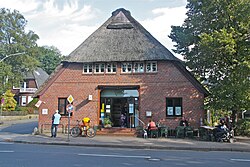Osdorf, Hamburg
Osdorf | |
|---|---|
 Thatched-roofed house in the center of the old Osdorf village | |
| Coordinates: 53°34′20″N 9°50′35″E / 53.57222°N 9.84306°E | |
| Country | Germany |
| State | Hamburg |
| City | Hamburg |
| Borough | Altona |
| Area | |
| • Total | 7.3 km2 (2.8 sq mi) |
| Population (2020-12-31)[1] | |
| • Total | 26,420 |
| • Density | 3,600/km2 (9,400/sq mi) |
| Time zone | UTC+01:00 (CET) |
| • Summer (DST) | UTC+02:00 (CEST) |
| Dialling codes | 040 |
| Vehicle registration | HH |

Osdorf (German language: pronounced German: [ˈɔːsdɔrf] ⓘ) is a quarter in the city of Hamburg, Germany. It belongs to the Altona borough. In 2020 the population was 26,420.[1]
History[edit]
In 1927 the former independent settlement Osdorf was made a part of the town Altona; in 1938 it was merged into the Hanseatic city of Hamburg with the Greater Hamburg Act.
After World War II, from 1950 to 1952, first new residential buildings were constructed near the streets of Blomkamp and Am Landpflegeheim. A major estate of prefabricated houses with 5,000 flats for 12,000 people, Osdorfer Born settlement, had been planned since 1963 and was erected from 1966 to 1971.[2]
Geography[edit]
In 2006, according to the statistical office of Hamburg and Schleswig-Holstein, Osdorf had a total area of 7.3 km2. The southern boundaries of Osdorf to the quarter Nienstedten lead along the railway tracks of the city train. In the west, the town of Schenefeld in Schleswig-Holstein and the quarter Iserbrook are located. To the east are the quarters Lurup, Bahrenfeld, and Groß Flottbek. Lake Helmuth Schack, located in the former moor area Deesmoor, lies in the quarter. The stream of Düpenau runs through the lake, Luruper Moorgraben flows into it.
Demographics[edit]
In 2006 in Osdorf were living 25,206 inhabitants. The population density was 3,459 inhabitants per square kilometre (8,960/sq mi). 18% were children under the age of 18, and 23.7% were 65 years of age or older. 13.4% were immigrants. 1,408 people were registered as unemployed and 6,651 were employees subject to social insurance contributions.[3]
In 1999 there were 12,148 households, out of which 23.3% had children under the age of 18 living with them and 39.2% of all households were made up of individuals. The average household size was 2.12.[4]
Population by year[edit]
The population is counted by the residential registration office for the December 31 each year.[3]
| 1987 | 1988 | 1989 |
| 23,347 | 25,918 | 25,974 |
| 1990 | 1991 | 1992 | 1993 | 1994 | 1995 | 1996 | 1997 | 1998 | 1999 |
| 26,410 | 26,858 | 26,739 | 26,993 | 26,625 | 26,332 | 26,084 | 25,599 | 25,601 | 25,487 |
| 2000 | 2001 | 2002 | 2003 | 2004 | 2005 | 2006 | 2007 | 2008 | 2014 |
| 25,477 | 25,675 | 25,909 | 25,993 | 25,417 | 25,297 | 25,106 | 25,204 | 25,070 | 25,901 |
In 2006 there were 2,402 criminal offences (96 crimes per 1000 people).[5]
Education[edit]
There were 4 elementary schools and 4 secondary schools in the quarter Osdorf, the Lise-Meitner-Gymnasium among the latter.[6]
A part of the Führungsakademie der Bundeswehr is located in the barracks Generalleutnant–Graf–von–Baudissin–Kaserne. The academy of the Bundeswehr educates officers for leading positions.
Culture[edit]
Recreation[edit]
The recreational area Bornpark is located at the border to Schleswig-Holstein. The Loki-Schmidt-Garten, also called Neuer Botanischer Garten (New Botanical Garden) is located in the area of the former independent municipality Klein Flottbek.
Infrastructure[edit]
Health systems[edit]
In Osdorf were 17 day-care centers for children, 48 physicians in private practice and 6 pharmacies.[6]
Transportation[edit]
Osdorf is serviced by the rapid transit system of the city train lines S1 and S11 with the stations Hochkamp and Klein Flottbek.
According to the Department of Motor Vehicles (Kraftfahrt-Bundesamt), in the quarter Osdorf were 9,445 private cars registered (474 cars/1000 people).[6] There were 123 traffic accidents total, including 106 traffic accidents with damage to persons.[7]
Notes[edit]
- ^ a b "Bevölkerung in Hamburg am 31.12.2020" (PDF). Statistisches Amt für Hamburg und Schleswig-Holstein. 23 April 2021.
- ^ Pferdeweiden neben Plattenbau und Nobelvilla, Hamburg.de
- ^ a b Residents registration office, source: statistical office Nord of Hamburg and Schleswig-Holstein (2006)
- ^ Source: statistical office Nord of Hamburg and Schleswig-Holstein (1999)
- ^ State Investigation Bureaux (Landeskriminalamt), source: statistical office Nord of Hamburg and Schleswig-Holstein (2006)
- ^ a b c Source: statistical office Nord of Hamburg and Schleswig-Holstein (2006)
- ^ Traffic accident statistic, statistical office Nord of Hamburg and Schleswig-Holstein (2006)
References[edit]
- Statistical office Hamburg and Schleswig-Holstein Statistisches Amt für Hamburg und Schleswig-Holstein, official website (in German)
- Osdorf, Hamburg.de
External links[edit]
- Academy of the Bundeswehr website (in German) Führungsakademie der Bundeswehr



